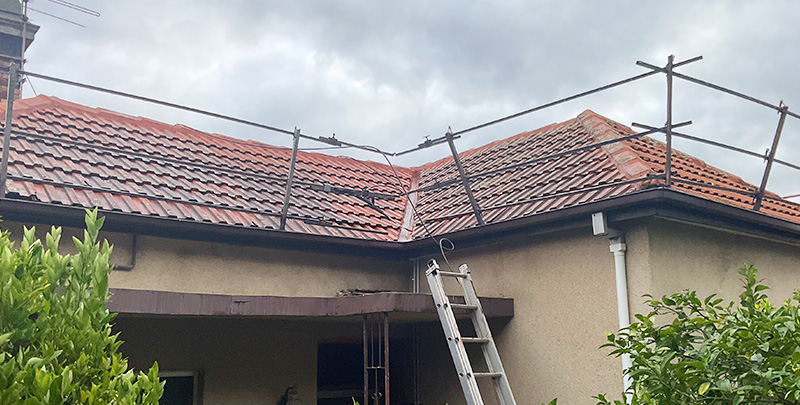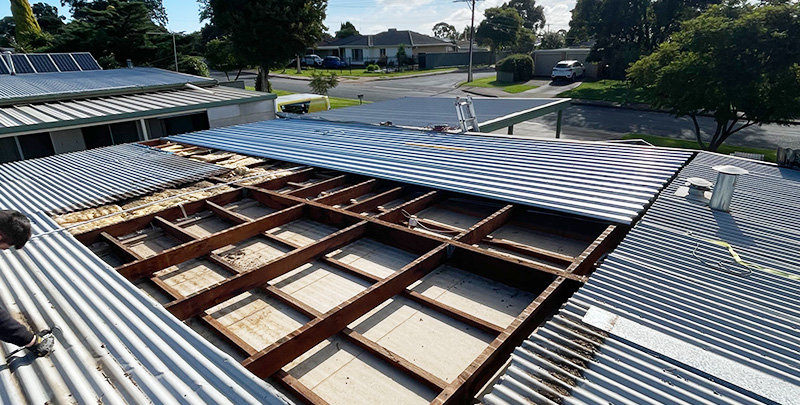7 Common Types Of Roof Damage: Causes, Signs, and Solutions

Did you know that catching roof damage early can save you a fortune in repairs or a complete roof replacement?
This comprehensive guide helps you spot the signs of roof damage, learn about common causes, and discuss preventative measures to protect your investment. Get ready to become a roof damage-detecting pro!
Common Causes of Roof Damage
Let’s start by understanding the common causes of roof damage. These include:
- Weather events, such as storms, hail, and high winds
- Age-related deterioration of roofing materials
- Poor installation
- Lack of maintenance
These factors can contribute to a damaged roof, potentially affecting the entire top and causing roof fungus damage.
These issues can lead to a roof leak, structural damage, and costly repairs if not addressed promptly.
Weather-related roof damage
Weather can be a primary culprit when it comes to roof damage. Storms, hail, wind, and extreme temperatures can all take their toll on various roofs, including metal roofs. Rain can cause significant damage to homes. For example, it can leave small dimples or dents on metal downspouts or outdoor HVAC units, indicating that the storm may have also damaged the roof.
Tree branches falling during storms or high winds can damage roofs, while heavy rainfall can cause water leaks and structural issues. Taking care of weather-related roof damage immediately is crucial to prevent further damage.
Age-related deterioration
As your roof ages, the materials start to wear down, resulting in issues such as:
- cracked shingles
- curled shingles
- granule-lacking shingles
- damaged flashing
These signs of age-related deterioration can lead to leaks and structural damage if left unchecked.
Regular inspections and maintenance can help you catch these issues early, saving you from expensive repairs or roof replacement.
Poor installation
Poor installation is another major contributor to roof damage. Inadequate installation work, such as roofing over existing asphalt shingles, not using suitable roof sealants, or not correctly fastening and overlapping the shingles, can result in premature roof damage. Your insurance might not cover this type of damage, making it essential to hire a reputable roofing contractor for installations, repairs or roof restoration.
Lack of maintenance
Lack of roof maintenance can also lead to roof damage. Failing to perform regular maintenance tasks, such as cleaning gutters, fixing minor leaks, or inspecting the roof, can exacerbate damage and result in costly repairs.
To keep your roof in good condition, schedule regular inspections and address minor issues promptly.

Types of Roof Damage and Their Symptoms
Now that we know the common causes of roof damage let’s discuss the types of damage and their symptoms. The most common types of roof damage include shingle damage, flashing damage, and gutter and downspout damage, identifying these issues will help you address them early and avoid costly repairs.
Shingle damage
Shingle damage can manifest in various ways, such as missing, lifted, or creased roof shingles. These signs may indicate potential wind or roof hail damage on your roof, which are some common symptoms of roof damage.
Regular inspections can help you spot shingle damage early, allowing you to address the issue before it worsens or leads to more expensive repairs.
Flashing damage
Flashing damage occurs when rust, tears, or gaps appear in the roof flashing – the metal or plastic strips used to seal joints between different parts of the top. Damaged flashing can lead to water leaks and wind damage, causing further damage to your roof and home.
Regular inspections and prompt repairs can help prevent flashing damage from escalating.
Gutter and downspout damage
Gutter and downspout include dents or granules collecting in the trenches, which can signify hail damage or aging shingles. Regularly cleaning and inspecting your gutters for damage can help you catch these issues early and prevent further roof damage.
You must check your gutters and downspouts for damage at least twice a year.
Leakage and Water Damage
Leaks are a common roof issue, often caused by damaged or missing shingles, improper installation of flashing, or clogged gutters. Water infiltration can lead to structural growth and interior water damage.
Roof Sagging
Roof sagging can occur due to structural issues, excessive weight from snow or debris accumulation, or improper installation. Learn why addressing sagging roofs promptly is crucial to prevent additional structural damage. Discover expert insights and tips in our latest blog.
Roof Vent Damage
Roof vents provide ventilation for attics and other enclosed spaces. If these vents are damaged or improperly sealed, they can allow water to enter, leading to leaks and potential moisture-related problems.
Ponding Water
Flat or low-slope roofs can sometimes develop areas of ponding water, where water pools and doesn’t drain properly. It can weaken the roofing materials and lead to leaks over time.
Regular roof inspections and maintenance are essential to identify and address these types of damages early, preventing more extensive issues and extending the roof’s LifeProof. If you suspect your roof has sustained damage, it’s advisable to consult a professional roofing contractor for a thorough assessment and necessary repairs.
Preventative Measures to Protect Your Roof
Taking preventative measures can go a long way in protecting your roof from damage. Regular inspections, proper ventilation and insulation, and tree trimming are all essential steps to maintain the health of your roof and avoid costly repairs or replacements.
You should perform inspections at least once a year to check for any signs of damage.
Regular inspections
Scheduling regular inspections can help you detect minor issues before they become costly problems. Our latest blog reveals the importance of conducting regular roof assessments.
A professional inspection can help you with issues, such as shingle damage or damaged flashing, allowing you to address them before they worsen.
Proper ventilation and insulation
Proper ventilation and insulation can prevent ice dams and reduce the risk of freezing damage. Well-maintained ventilation and insulation systems can help regulate the temperature of your roof, preventing snow and ice buildup during winter months.
Additionally, proper ventilation reduces moisture in the attic, further protecting your roof from damage.
Tree trimming
Tree trimming is essential for preventing branches from damaging your roof during storms or high winds. Keeping trees near your top trimmed and removing dead or sick branches can help protect your roof from potential damage.
Regular tree maintenance can also prevent debris from clogging your gutters and downspouts, ensuring proper drainage and reducing the risk of water damage.

Handling Roof Damage: Repair or Replace?
When faced with roof damage, it’s crucial to determine whether repairs or complete replacements are necessary. Assessing the extent of damage, considering costs, and evaluating the roof’s lifespan can help you make the right decision to protect your home or wallet.
Repairing roof damage may be the best option if the damage is minor and the roof is relatively new, but in some cases, roof repairs might be necessary.
Assessing the extent of damage
One of the first steps in addressing roof damage is assessing the extent of the issue. Inspecting your roof for:
- Missing shingles
- Cracked shingles
- Curled shingles
- Signs of water damage
It can help you determine whether repairs or a complete replacement are needed.
A professional inspection can also provide a more accurate assessment of the damage and guide you in making the best decision for your home.
Cost Considerations
Cost is substantial when deciding whether to repair or replace your roof. Minor repairs might be more cost-effective in the short term, but if your roof is nearing the end of its lifespan or has extensive damage, a complete replacement could be more economical in the long run.
Getting multiple quotes from roofing contractors is essential to ensure you make the best decision for your budget and home.
Roof Lifespan
When deciding whether to repair or replace your roof, it’s essential to consider its age and overall condition. A typical roof lasts between 20 and 30 years, and older roofs may be more susceptible to damage. If your roof is nearing the end of its lifespan, a complete replacement might be a more cost-effective solution in the long run.
It’s important to weigh each option’s pros and cons before deciding.
Filing an Insurance Claim for Roof Damage
If your roof has sustained damage, filing an insurance claim can help cover the cost of repairs or replacement. To successfully file a claim, it’s crucial to understand your policy, document the damage, and work with a professional roofer who can provide accurate repair estimates and assist with the claims process.
Understanding your policy is the first step. Make sure you know what is covered and what is not.
Understanding Your Policy
Before you file a claim, you must understand the types of roof damage your homeowners’ insurance policy covers and any applicable deductibles.
Some policies may cover weather-related damage, such as hail or wind, while others might not cover age-related.
Documenting the Damage
To support your claim, it’s crucial to document the damage thoroughly. Take photos and notes of any missing, cracked, or curled shingles and signs of water damage, like stains on the ceiling or walls.
This documentation can help contractors and your insurance company, ensuring a smooth claims process and accurate repair estimates.
Working with a Professional Roofer
Working with a professional roofer can significantly assist in the insurance claims process. Roofing professionals can:
- Assess the condition of your roof
- Identify any issues
- Prepare damage reports
- Provide accurate repair quotes
- Help you navigate the claims process
- Work with your insurance company to ensure a successful outcome.
Insurance companies often require detailed documentation of the damage and repair costs. A roofing professional can do this for you.
Addressing the Roof Damage Effectively
In conclusion, proactively detecting and addressing roof damage can save you from costly repairs or a complete roof replacement. By understanding the common causes of roof damage, recognising the signs, and taking preventative measures, you can protect your home and wallet. Don’t wait until it’s too late – inspect your roof regularly, work with a professional roofer, and keep your home in shape.
Please note: This information is provided for advice purposes only. Regulations differ from state to state, so please consult your local authorities or an industry professional before proceeding with any work. See our Terms & Conditions here.